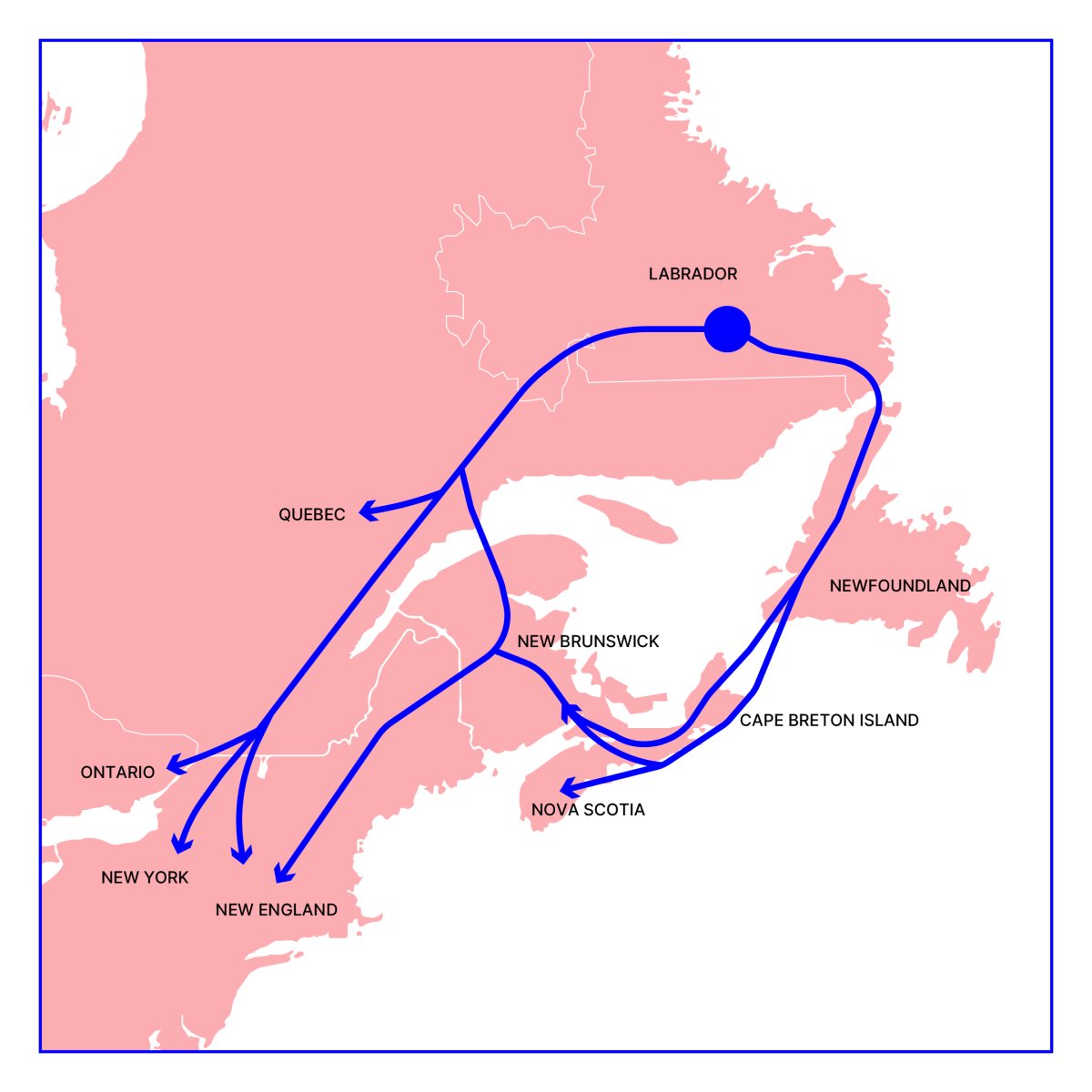Support strong Canadian climate journalism for 2025
In Labrador, a proposed hydro dam twice the size of British Columbia’s Site C megaproject, looms large over the East Coast’s energy future. The project is called Gull Island, and it is a beast.
Gull Island would be built about 300 kilometres from the Quebec border on Labrador’s Churchill River. The hydro plant would generate 2,250 megawatts (MW) of electricity – roughly the equivalent of five million solar panels or enough power for more than 1.5 million homes.
“Gull Island is a phenomenal resource, and it should be something that is in our society as a solution to what the world needs,” Newfoundland and Labrador Hydro CEO Jennifer Williams told Canada’s National Observer in an interview. “But it has to be the right solution.”
Like most hydro projects, it promises to be controversial, given it would flood an 85-square-kilometre area of the Innu Nation’s traditional territory for its reservoir. But as the region looks for new sources of clean electricity, the pieces are slowly falling into place for its construction.
Multiple factors are driving demand for new clean electricity, including electric vehicles, heat pumps and industrial decarbonization. At the same time, Nova Scotia and New Brunswick are phasing out their coal-fired power plants, and Quebec wants to add thousands of megawatts of electricity over the coming decades to secure its position as a continental electricity supplier as the energy transition unfolds.
To accomplish all this, Atlantic Canada, Quebec and the federal government are bound together in a project called the Atlantic Loop. The Atlantic Loop is a plan to connect and strengthen the region’s power grids to meet the demands of the energy transition. Atlantic Canada is planning to go big on wind, but it is Gull Island, first proposed over 50 years ago, that is set to define the region’s energy future.
Cursed by geography
Since the early 1970s, successive governments in Newfoundland and Labrador have sought to build the Gull Island megaproject, but have never been able to turn plans into action.
Despite the project’s potential, it’s simply too large for the province to pursue on its own. To make economic sense, it would require a deal with other jurisdictions, like Quebec, which historically has been viewed as an unfair partner by Newfoundlanders and Labradorians.
The dam itself would cost billions to build, but that’s only the beginning of the problem. To actually sell the power would require transmission lines across Labrador’s rugged terrain and through Quebec, or subsea cables into the Maritimes. Between building electricity generation and transmission, Gull Island is really two complex and expensive megaprojects rolled into one mammoth project.
“Gull Island can produce far more energy than the province presently requires or reasonably expects to require in the immediate future,” reads a 2012 report produced by Newfoundland and Labrador’s department of natural resources. “Therefore, the project can only proceed with access to secured long-term customers in external markets, such as Ontario and other northeast markets including the United States via Quebec.
“The story… to date has been about the tremendous Gull Island power resource with no access to external markets,” the report adds.
But that story is changing in an era of decarbonization. As renewable electricity demand grows, Gull Island is looking more promising.
That’s not to say it will be smooth sailing. Newfoundland and Labrador is still “cursed by geography,” said Larry Hughes, an energy system expert and professor at Dalhousie University.
It is a huge challenge to transmit the electricity to paying customers. Transmission lines can be built west through Quebec, or east to the island of Newfoundland, and south across a 170-km patch of ocean called the Cabot Strait to Nova Scotia. Both are expensive and involve the cooperation of other jurisdictions.

Reaching markets in Ontario, New York and New England is vital for Newfoundland and Labrador to profit from Gull Island. But the province isn’t starting from scratch. A subsea transmission line already exists from Newfoundland to Nova Scotia’s Cape Breton Island. The Maritime Link was built at a cost of $1.7 billion so Nova Scotia could import power from Muskrat Falls – an 824-MW dam also on the Churchill River – akin to Gull Island’s younger sibling. But capacity on the Maritime Link is limited and can’t support Gull Island exports on its own.
Moreover, Nova Scotia is skeptical about cooperating with Newfoundland and Labrador.
“Nova Scotia continues to raise concerns over the potential technical challenges with the Atlantic Loop projects given its very recent experience with the Labrador Island Link/Maritime Link project, where technical challenges led to delays and significant costs for Nova Scotians in replacement electricity,” reads a briefing note prepared for Energy and Natural Resources Minister Jonathan Wilkinson ahead of a meeting with Nova Scotia Premier Tim Houston, that Canada’s National Observer received through a federal access to information request.
To compensate Nova Scotia’s publicly traded utility Emera for incurring higher than expected costs, this week the federal government announced it would begin negotiations on a $500-million bailout package.
But, if Gull Island’s potential East Coast route to market is politically challenged, its western route through Quebec also promises to be daunting. Quebec is an energy superpower with a long history of hardball negotiations with Newfoundland and Labrador.
Hydro-Québec is the largest utility in the country and one of the largest in North America. Newfoundland and Labrador, on the other hand, is a much smaller regional energy producer, so negotiating a transmission line through Quebec to help Newfoundland and Labrador profit, is practically a non-starter unless Quebec benefits from the deal.
Quebec is interested. Hydro-Quebec estimates it will need to add between 8,000 to 9,000 MWs of electricity by 2050, to replace fossil fuels and meet Premier François Legault’s vision of becoming the “battery of North America.” Gull Island is large enough to potentially supply 10 per cent of Hydro-Quebec’s needs, and Legault is openly discussing options to secure the power with Newfoundland and Labrador Premier Andrew Furey.
Long history of playing hardball
Quebec has a long history of wielding its mighty influence over the region’s energy landscape.
“When Newfoundland and Labrador joined Confederation, [Premier] Joey Smallwood's dream was to have a large industrial base and a hydroelectric system,” Hughes said. Underpinning the dream of using hydroelectric power to build a strong economy was a dam called Churchill Falls.
With more than 5,000MW of capacity, Labrador’s Churchill Falls is Canada’s second largest hydro plant. As early as the 1950s, Smallwood wanted it built to sell electricity to Ontario.
But Quebec “wouldn’t allow that,” said Hughes, and with the federal government unwilling to force it, a deal between Quebec and Newfoundland and Labrador was reached in the 1960s. The deal favoured the much more powerful Quebec, which built the dam in exchange for a fixed, long-term contract guaranteeing a price of less than half a cent per kilowatt-hour.
“It was dirt cheap, and today, Churchill Falls supplies about 15 per cent of Quebec's electricity needs,” Hughes said, adding that Newfoundland and Labrador has challenged the deal in court but never won.
The most recent figures show the deal has garnered more than $28 billion in profits for Quebec compared to about $2 billion for Newfoundland and Labrador. The current contract expires in 2041.
It is impossible to understand Newfoundland and Labrador’s energy ambitions without understanding just how painful this deal was to the province. Feeling taken advantage of and prideful, successive Newfoundland and Labrador governments, from the 1970s to present, have attempted to develop hydro resources like Gull Island to compete with Quebec.
The province gave up on Gull Island after multiple failed attempts, and a decade ago, built Muskrat Falls, running transmission lines along an eastern route, from Labrador to Newfoundland to Nova Scotia –– effectively cutting Quebec out. In 2018, former premier Danny Williams admitted his decision to greenlight Muskrat Falls came after being “thwarted” by Quebec. He liked the idea of selling electricity abroad independently.
If the province builds a much larger dam like Gull Island, it will be important for the province to keep lessons learned from Muskrat Falls in mind, said Williams. One of those includes a better relationship with the Innu Nation, which has said Gull Island would be dead on arrival unless an outstanding dispute is resolved over a Muskrat Falls impacts and benefits agreement, potentially worth billions of dollars.
"You can safely say that Gull Island is dead. It's not coming back on stream, ever, as long as this [Muskrat Falls dispute] is outstanding," Peter Penashue, the former Innu Nation Grand Chief and longtime negotiator for the nation, told CBC/Radio-Canada in an interview last year.
In early September, Innu leadership met with Newfoundland and Labrador Premier Andrew Furey to discuss potential hydro projects, and reaffirmed that message. The Innu Nation said it won’t back down from a legal challenge currently before the courts until an agreement is worked out.
Innu leadership could not be reached for comment before publication.
Williams said one of her goals since she took the helm of the Crown utility is to foster a stronger relationship with the Innu Nation.
“It's the right thing to do, but as it relates to any kind of future development, hopefully having a good relationship is a better starting point than not having that,” she said.
2041 negotiations
In 2041, the lopsided Churchill Falls deal with Quebec expires, and Newfoundland and Labrador could be in control of that massive project, adding thousands of megawatts of electricity to its portfolio. The two provinces are already negotiating the hydro plant’s future because while the expiry date is 16 years away, that is a blink of an eye in the world of electricity planning given new dams can take nearly a decade to build.
“In 2041, we'll have a huge amount [of electricity] available,” Williams said. “4,000MW of hydropower - clean, renewable, power.
“So I very much see our jurisdiction as available to be the resource that can supply [the region],” she said.






Comments
If this hydroelectric project ever comes to fruition it will be to the benefit of Quebec while the Atlantic provinces will continue to rely on oil.
New Brunswick has had opportunities to increase flow of power from QC for decades. Instead of increasing capacity to import that power, NB chose to build fossil fuel plants. That wasn't Québec's fault.
Hydro-Québec is the largest utility in the country and one of the largest in North America!
It is also by itself the 5th largest Hydro generator in the world, with Canada being tge third largest. NL is 98 % Hydro, PEI 100% renewable generation but buys most electricity from NB. Which is quite quickly going renewable.
NS has recently proposed a plan to eliminate coal and go 100 % renewable
The problem with Gull Island will be cost as Manitoba and BC Hydros discovered when their recent dams cost 2x as much as estimated and that cannot compete with the much liver cost of wind and solar
This is a helpful explication of a complicated project although it also has a few weak points. You can tell it s not written by someone from Atlantic Canada; sensitive it is not.
I will just draw attention to one nasty context: Emera aka NSPower is an American company that bought out the provincially owned power system (from a Con regime) some years ago and has been nothing but a big black hole sucking our finances to its shareholders while delivering less than adequate power to citizens here. They want to raise our rates 19% to cover their badly planned losses. And that s just for now.
I despise every fraction of a cent I have to pay them and would adore for us to be able to buy it back to serve us locals again.
Cmon, feds: you re putting up half a billion to defer those rates temporarily? cough up another half and see if they ll slink away!
The continent desperately needs that giant battery, to make wind and solar work. Everybody knows storage is the real key to getting off fossil and onto renewables. BC and MB need to become giant batteries for the prairies, Eastern Canada needs to become a giant battery for the huge NE coast of the USA.
The green transition just won't work without storage. Pay the Innu what they ask, spend what it takes, get it built.
Quebec (Hydro Quebec (HQ)) won't be a battery for anyone; it will be managing water levels (i.e. generation) to maximize benefit to Quebecers (as it should be expected to). Full stop. That is to say, such benefit won't include holding back water (when some current generation capacity is unused) to keep the lights on next month in Boston unless there is a likelihood of a larger future payback, which has presumably been incorporated in any supply contracts.
Further, what Quebec can supply to the North American market (specifically to markets outside Quebec) is a small percentage of what is currently needed and even less of what will be needed in the future.
HQ present generation capacity is ~37 GW and, in 2023, supplied ~200 TWh (200,000 GWh) to all its customers. In 2023, HQ exported only ~21,400 GWh. In 2022, the total American electrical generation was 13.3 quads, which converts to ~3,897,845 GWh. Thus, the TOTAL 2023 HQ generation represents ~5% of 2022 electricity generation in the USA. You can do the math regarding what percentage of total US electrical generation is that 21,400 GWh that was actually exported, to all customers outside Quebec, by HQ. (In 2022, HQ exported only about 9,000 GWh).
https://flowcharts.llnl.gov/sites/flowcharts/files/2023-10/US%20Energy%…
https://www.hydroquebec.com/data/documents-donnees/pdf/annual-report-20…
Aren't power exports from QC more profitable than internal use? Plus, Hydro Québec has export contracts they must satisfy. I think NL has an opportunity to drive a pretty good bargain here. Given the Maritime Link, another twin subsea line with transmission thru NB to NE might be dangled by Feds if QC doesn't play fair.
I couldn't tell you which kWh is more valuable: one sold to a local resident or one sold to an American utility, but the 'value' is determined by much more than the unit cost.
Quebecers enjoy generally low hydro rates and would kick up a stink, I expect, if there was a move to increase retail rates substantially. Also, the Quebec gov't has its industrial plan which is to supply cheap electricity to energy-intensive industry --e.g. aluminum smelters -- and it is looking for more rivers to dam. On that score, I agree with you that NL is not without some leverage (even concerning the 2041 end date of the Churchill Falls contract, perhaps) if damming more of its rivers means that Quebec would have access to more electricity that it really (really) wants.
In figuring out where things truly stand, I think one also needs an understanding (which I certainly don't have) of why Sophie Brochu, former PDG of HQ, resigned the post in April 2023 over what seemed to be a difference of opinion with the Caquiste gov't concerning the strategic goals and, perhaps??, the raison d'être actuelle of HQ.
As to the notion of playing fair, I don't think that's actually a thing anymore; playing to win is the order of the day in our "I, not We", "Competition, not Cooperation" society. Which, IMO, is what is preventing us from actually doing anything meaningful on the ecological polycrisis. But I digress.
I think you've pointed out the weakness in Hydro Québec's position. They make much of their profit from exports (partly as you point out because of the low price they charge to residents) and like other hydro reliant power generators, they're faced with impacts of drought on production. Not sure that they can meet the dream of being a battery for NE without NL's power.
Québec's position re NL is weak and getting weaker. If the Feds indicate support for a second subsea cable to the Maritimes, QC will have to make concessions to get Gull and Muskrat power.
Well-written article, though I'd temper enthusiasm for Hydro Quebec's contribution to the grand scheme by noting some stats I placed in a reply elsewhere in these comments.
My only other quibble is with respect to to having two quoted people having the same last name. Perhaps subsequent references to each (Williams) should have some further qualification???